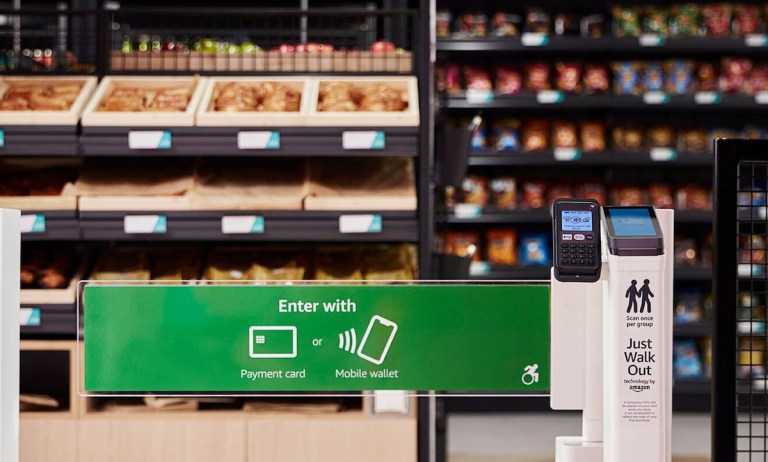
As Amazon looks to license its Just Walk Out checkout system to more stores, the eCommerce giant is upgrading the artificial intelligence model to improve accuracy.
The company announced in a blog post Wednesday (July 31) that the new multimodal AI foundation model uses advanced machine learning techniques, akin to those used in generative AI applications, to analyze data from cameras and sensors concurrently. This marks a departure from the previous sequential data analysis method, addressing issues such as camera obstructions and complex shopper behaviors more effectively.
“What we realized in the past couple of years is … we could combine all of these different signals into a single model and … teach a machine learning system to operate on the entirety of that information all at once to produce a receipt,” Jon Jenkins, vice president of Just Walk Out technology, shared on a call. “… When we took this multimodal, single foundation model approach, we found out that we could generate receipts faster, more efficiently and more accurately than we were able to with the existing system, which was already pretty good.”
Jenkins explained that this foundational technology allows Just Walk Out to process and integrate multiple types of data inputs — video from cameras, weight signals from sensors, RFID signals and images of items taken off shelves — into a comprehensive model, which is “kind of a game changer.”
Many consumers, for their part, are interested in this kind of checkout system, according to the PYMNTS Intelligence study “How We Will Pay Report: How Connected Devices Enable Multitasking Among Digital-First Consumers.” Specifically, among the 95% of consumers who own connected devices, 35% would be interested in an experience where they walk into a store, pick up a product and walk out without standing in a checkout line to pay. Sensors detect what they have put in their cart, and they are automatically charged for those items using an app with the payment method. Additionally, 6% said they already do this.
Amazon’s Just Walk Out technology is gaining traction beyond its own stores, with over 170 installations in third-party locations, Jenkins said. Initially launched under Amazon’s retail division, the project shifted to AWS around two years ago to better serve non-Amazon businesses.
“There are going to be way more non-Amazon stores than Amazon stores,” Jenkins remarked, highlighting the need to cater to a broader market.
The pivot focuses on making the technology easily installable and operable for a range of external customers. Jenkins emphasized that Amazon’s own stores, like Amazon Go and Amazon Fresh, are now treated as just another customer among many. Most new installations are third-party locations, including airports and stadiums. For instance, Hudson operates 16 Just Walk Out-enabled stores in airports across the country, and several stadiums, including Lumen Field and the Washington Commanders’ stadium, have embraced the technology.
Jenkins highlighted several key areas where the technology is beginning to catch on. The initial large-scale third-party deployments of Just Walk Out were in stadiums across the country. Jenkins cited Lumen Field as an example, where the technology increased customer throughput by 85% and more than doubled revenue in the same space.
Additionally, in cases where stores need to, say, stay open overnight, the technology, operating unattended, is meant to present a viable financial model during those off-peak hours. Plus, in areas that see short bursts of high traffic, the technology is meant to allow these venues to manage increased demand without increasing labor costs, optimizing staffing efficiency.
Jenkins also stated that high-theft locations see a marked decrease in shrinkage with Just Walk Out. The technology effectively converts potential theft into legitimate purchases, as items taken off the shelf are automatically added to the customer’s virtual cart.
Additionally, for new facilities, Just Walk Out allows architects to allocate less space to retail areas. This reduction, Jenkins said, translates into cost savings in construction and operational efficiency.
For all PYMNTS retail coverage, subscribe to the daily Retail Newsletter.